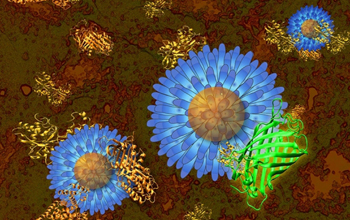Multimedia Gallery
Engineering nanoparticles to improve human health
This image depicts a nanoparticle-based sensing strategy for determining protein levels in blood. In this approach, green fluorescent protein (GFP) binds to the surface of gold nanoparticles, quenching fluorescence. Displacement of the GFP by analyte proteins turns on fluorescence, providing the signal that is used for blood profiling.
Vincent Rotello, a nanochemist at the University of Massachusetts Amherst, is engineering nanoparticle surfaces for widespread applications in therapeutics, diagnostics and tissue engineering. One key challenge Rotello and his research group are addressing is how to design materials to interact in controlled fashion with proteins. Rotello has developed new systems for delivering proteins into cells, as well as surfaces that are highly resistant to protein adhesion, with applications for implantable sensors and other biomedical devices. For his creative and translational research, Rotello has been appointed distinguished professor. This research is being conducted through the Center for Hierarchical Manufacturing at UMass, a National Science Foundation Nanoscale Science and Engineering Center (NSEC).
This research was part of the TRG3 (Sensors and Environmental Monitoring) of the NSEC-sponsored Center for Hierarchical Manufacturing (under NSF grant CMMI 10-25020). (Date of Image: 2014)
Credit: Vincent Rotello, University of Massachusetts
See other images like this on your iPhone or iPad download NSF Science Zone on the Apple App Store.
Images and other media in the National Science Foundation Multimedia Gallery are available for use in print and electronic material by NSF employees, members of the media, university staff, teachers and the general public. All media in the gallery are intended for personal, educational and nonprofit/non-commercial use only.
Images credited to the National Science Foundation, a federal agency, are in the public domain. The images were created by employees of the United States Government as part of their official duties or prepared by contractors as "works for hire" for NSF. You may freely use NSF-credited images and, at your discretion, credit NSF with a "Courtesy: National Science Foundation" notation.
Additional information about general usage can be found in Conditions.
Also Available:
Download the high-resolution JPG version of the image. (2.2 MB)
Use your mouse to right-click (Mac users may need to Ctrl-click) the link above and choose the option that will save the file or target to your computer.



